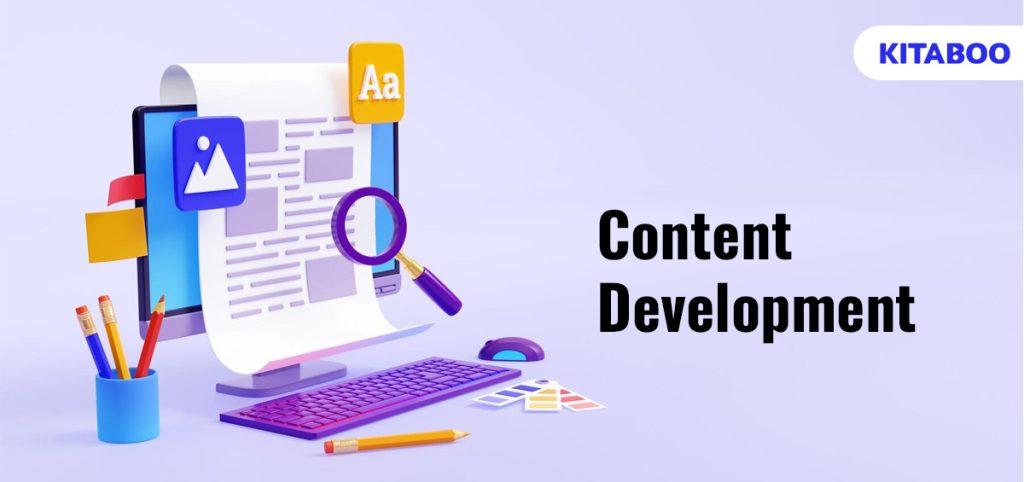
Mastering Content Development: A Guide for Publishing Leaders
Content development is one of the most important aspects of the publishing workflow. The approach to content creation in the digital era looks significantly different than in traditional publishing.
Forward-thinking K12 publishing companies are investing in tech-enabled solutions to bring more efficiency to the process and produce highly engaging, interactive educational content. For instance, by leveraging a digital publishing platform like KITABOO, publishing companies can completely automate and optimize the content creation, publishing, and distribution process.
Leveraging a tech-enabled approach to content development serves multiple business goals of the K12 publisher. These can range from building relevant, engaging content with an emphasis on accessibility to safeguarding revenues and protecting content from piracy.
As organizations make these shifts, managing the content creation process can become overwhelming for publishing leaders managing multiple teams and projects. This blog can serve as a guide to leveraging technology to its full potential and making a smooth transition in the process.
Table of Contents
I. Mastering New-age Content Development
- Clearly Define Content Development Outcomes
- Invest in Strategic Instruction Design
- Build Tech-Enabled Processes
- Function With Lean Teams
- Focus On Digital Rights Management
- Build Accessible Products
- Make Data-Driven Decisions
II. Conclusion
Mastering New-age Content Development
Here’s a snapshot of how educational publishing team leaders can build stronger teams, foster a culture of collaboration, and produce high-impact, engaging, and effective educational content in this new-age.
Clearly Define Content Development Outcomes
The first goal of any project is to identify aspects such as the target audience, key content management strategies, and timelines.
For instance, the outcomes of a K12 project would be radically different outcomes than of a professional skilling project. The subject matter, target audience, learning methodologies, and learning effectiveness measurability would differ.
Having a blueprint template with all the basic details helps publishing teams have a clear understanding of the expected outcomes. Content development strategies can be developed accordingly.
Invest in Strategic Instruction Design
Publishers must invest enough resources in instructional design, one of the most important pillars of educational content development.
Instructional designers can simplify the learning process, help maximize production resources, enhance the user experience, and recommend key metrics to measure content success.
Putting into place best practices related to instructional design can yield superior content, higher engagement, and greater learning effectiveness.
Automate The Production Process
One of the top investments for publishers is the automation of publishing processes. For instance, the use of a digital publishing suite such as KITABOO can help automate processes such as typesetting.
Instead of having to manually organize and create sections, citations, table of contents, and cross-referencing, from scratch, publishing teams can let the software do the work.
They also create interactive eBooks seamlessly, interspersing multi-media content with text and images. The use of automation reduces errors and repetitive tasks, freeing up the bandwidth of teams for higher-value, more strategic tasks.
Function With Lean Teams
Contemporary publishers need to run a tight ship. Hiring large teams can be counterproductive as technology now has the ability to automate multiple functions within the content publishing workflow.
Instead, publishers must focus on the skills needed and build lean hybrid teams that can collaborate on projects and complement each other’s skill sets.
Some members with specialized skill sets could function as consultants, while others with key skills can be on payrolls. The use of cloud-based, automated digital publishing interfaces such as KITABOO makes it easier for individuals to work collectively on projects. .
This kind of mix can help publishers run a cost-effective, efficient operation.
Focus On Digital Rights Management
Piracy, duplication of content, and plagiarism are major concerns for publishing leaders. These practices eat into business revenues. Fortunately, technology now delivers solutions to support businesses and protect revenues.
Today, digital tools like KITABOO come with a robust digital rights management functionality, enabling publishers to control content access and deliver content seamlessly and securely to authorized users.
Build Accessible Products
Accessibility is one of the top values publishers must factor into their content development plans. Creating access opens up a whole new set of diverse audiences seeking your product.
By leveraging new-age digital publishing tools, publishing teams can create accessible products with features such as audio representations, publication of content in multiple languages, font adjustment, and video captioning.
Consumers with disabilities, learning challenges, and language limitations can engage with content, thus enabling businesses to derive higher ROI on the same content.
Make Data-Driven Decisions
One of the upsides of producing digital content is the in-depth access to data. Superior digital publishing tools come with robust AI-driven predictive analysis tools, which enable publishers to turn data into actionable insights.
They can understand consumer behavior and predict consumer trends early on. Publishing teams must leverage these insights to make editorial decisions.
Conclusion
Empowering content creation teams with modern digital publishing tools is a step towards building highly differentiated and effective K12 content.
Superior digital publishing tools leverage the benefits of technologies such as automation, AI, Machine Learning, Natural Language Processing, Gamification, and Virtual Reality to build unique content experiences. Technology is also helping businesses streamline and optimize the content development process, with multiple outcomes such as protecting revenues, functioning with lean teams, and driving profitability.
If your publishing team aspires to produce and distribute high-quality eLearning content, KITABOO is geared with the right technology solutions to support you in your mission.
To leverage our cloud-based digital publishing platform, write to us at contact@kitaboo.com.
Discover how a mobile-first training platform can help your organization.
KITABOO is a cloud-based platform to create, deliver & track mobile-first interactive training content.


